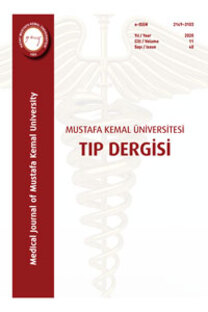ENDOMETRİOZİSE BAĞLI AĞRI TEDAVİSİNDE LEVONORGESTREL SALGILAYAN RAHİM İÇİ ARAÇ SİSTEMİ (LNG-RİA) VE NAPROKSEN SODYUM ETKİNLİĞİ KARŞILAŞTIRILMASI
Endometriozis, levonorgestrel salgılayan rahim içi araç (LNG-RİA), naproksen sodyum, ağrı tedavisi
In Endometriosis Treatment of Pain Due Levonorgestrel Releasing Intrauterine Vehicle System (LNG-IUD) to Event and Comparison Naproxen Sodium
Endometriosis, levonorgestrel releasing intrauterine device (LNG IUD), naproxen sodium, pain management,
___
- Mahmood TA, Templeton A, Thomson L, Fraser Cl. Menstrual symtoms in women with pelvic endometriosis. Br J Obstet Gynecol 1991; 98: 555-63.
- Barry AR, Daniel CM. Endometriosis and chronic pelvic pain. Obstet Gynecol Clin NA 1993; 20: 709-17.
- Fedele L, Parazzini F, Bianchi S, Arcaini L, Candiani GB. Stage and localization of pelvic endometriosis and pain. Fertil Steril 1990; 53: 155-58.
- Fedele L, Bianchi S, Bocciolona L, Di Nola G, Parazzini F. Pain symptoms associated with endometriosis. Obstet Gynecol 1992; 75: 767-69.
- Mishell DR Jr. Intrauterine devices. Curr Ther Endocrinol Metab 1997; 6: 285-92.
- Eray S , Bakır SA, Hazar Aİ , Güneş J , İzmir M , Ortaylı N , et al. Farma List (1. baskı). 2001, Farmatıp Yayıncılık: Ankara. 388-405.
- Melzack R. The McGill Pain Questionnaire: Major properties and scoring methods. Pain. 1975; 1: 277-99.
- Kuğuoğlu S, Aslan FE, Olgun N. McGill Melzack ağrı soru formunun (MASF) Türkçe'ye uyarlanması. Ağrı. 2003; 47-51.
- Carter JE. Chronic pelvic pain diagnosis and management. http:www.obgyn.net/displayarticle.asp?page=/english/pubs/features/Carter/cpp_car
- Howard FM, El-Minavi AM. Taking a History. FM. Howard, CP. Perry, JE. Carter ve AM. El-Minavi (Eds.) , Pelvic Pain Diagnosis and Management, in Lippincott Williams & Wilkins. 2000; 7-25.
- Eti Aslan F. Ağrı Doğası ve Kontrolü (1. Baskı). 2006: Avrupa Tıp Kitabevi, İstanbul.
- Eskenazi B, Warner ML. Epidemiology of endometriosis. Obstet Gynecol Clin North Am 1997; 24: 235-38.
- Kerr WJ. Endometriosis involving the urinary tract. Clin Obstet Gynecol 1966; 9; 331-57.
- Olive DL, Pritts EA. Treatment of endometriosis. N Engl J Med 2001; 345: 266.
- Prentice A , Deary AJ, Goldbeck-Wood S, Farquhar C, Smith SK.Gonadotropin-releasing hormone analogues for pain associated with endometriosis. Cochrane Database Syst Rev 2000. (2):CD000346.
- d' Arcangues C. WHO statement on hormonal contraception and bone health. Contraception. 2006; 73: 443-4.
- Vercellini P, De Giorgi O, Oldani S, Cortesi I, Panazza S, Crosignani PG. Depot medroxyprogesterone acetate versus an oral controceptive combined with very-low-dose danazol for long-term treatment of pelvic pain associated with endometriosis. Am J Obstet Gynecol 1996; 175: 396-401.
- Lockhat FB, Emembolu JO, Konje JC.The efficacy,side-effects and continuation rates in women with symptomatic endometriosis undergoing teratment with an intra-uterine administered progestogen (levonorgestrel): A 3 year follow-up. Obstet. Gynecol Surv 2005; 60: 443.
- Luukkainen T, Pakarinen P, Toivonen J. Progestin-releasing intrauterine systems. Semin Reprod Med 2001; 19: 355-63.
- Katzung BG.In Basic and Clinical Pharmacology, Appleton Lange, Katzung BG(Eds), 1995: Conneticut. 536-560.
- Marjoribanks J , Proctor M, Farquhar C. Nonsteroidal anti-inflammatory drugs for primary dysmenorrhoea. Cochrane Database Syst Rev, 2003. (4): p. CD001751.
- Kauppila A, Ronnberg L. Naproxen sodyum in dysmenorrhea secondary to endometriosis. Obstetrics and Gynaecology 1985; 65: 379-83.
- Vercellini P, Aimi G, Paonazza S, De Giorgi O, Pesole A, Crosignani PG. A levonorgestrel-releasing intrauterine system for the treatment of dysmenorrhea associated with endometroisis: a pilot study. Fertil Steril 1999; 72: 505-8.
- Vercellini P , Frontino G, De Giorgi O, Aimi G, Zaina B, Crosignani PG.Comparison of a levonorgestrel-releasing intrauterine device versus expectant management after conservative surgery for symptomatic endometroisis : A pilot study Fertil Steril 2003; 80: 305-9.
- Fedele L, Bianchi S, Zanconato G, Portuese A, Raffaelli R. Use of a levonorgestrel-releasing intrauterine devive in the teratment of rectovajinal endometriosis. Fertil Steril 2001; 75: 485-88.
- Lockhat FB, Emembolu JO, Konje JC. The evaluation of the effectiveness of an intrauterine-administered progestogen (levonorgestrel) in the symptomatic teratment of endometriosis and in the staging or the disease. Hum Reprod 2004; 19: 179-84.
- Petta CA , Ferriani RA, Abrao MS, Hassan D, Rosa E Silva JC, Podgaec S,et al. Randomized clinical trial of a levonorgestrel-releasing intrauterine system and a depot GnRH analogue for the treatment of chronic pelvic pain in women with endometriosis. Hum Reprod 2005; 20: 1993-98.
- ISSN: 2149-3103
- Yayın Aralığı: Yılda 3 Sayı
- Başlangıç: 2010
- Yayıncı: Hatay Mustafa Kemal Üniversitesi Tıp Fakültesi Dekanlığı
Minimal İnvaziv Pektus Karinatum Onarımı; Bir Yıllık Deneyim
Tırnak Batmalarının Tedavisinde Kama Şeklinde Çıkarımla Birlikte Yeni Bir Sütür Tekniğinin Sonuçları
Metin Temel, Ebru Çelik, Raif Özden, Asena Çiğdem Doğramacı, Yunus Doğramacı, Vedat Uruç
Şengül Talar ARSLAN, Bünyamin BÖREKÇİ, Emsal Pınar TOPDAĞI
Kolon Kanserinde S100A4 Ekspresyonunun Klinik ve Patolojik Önemi
Epitelyal Prekanseröz Lezyonlar/Epithelial Precancerous Lesions
Göğüs Duvarında Bir Ay İçinde Hızla Büyüyen Fibrosarkom Vakası
SİGARA DUMANININ NEDEN OLDUĞU AKCİĞER İNFLAMASYONUNA KARŞI ALFA-LİNOLENİK ASİTİN KORUYUCU ROLÜ
Halil Mahir KAPLAN, Figen DORAN
Primer Adrenal Schwannoma-Nadir Bir Vaka
Uterin Serviks Kanserinin Atipik Prezentasyonu: Olgu Sunumu
STEREOTAKTİK RADYOTERAPİNİN AKUSTİK NÖRİNOMA HASTALARI ÜZERİNE ETKİSİ
Suphi Bulğurcu, İlker Burak Arslan, Ömer Uğur, İbrahim Çukurova
